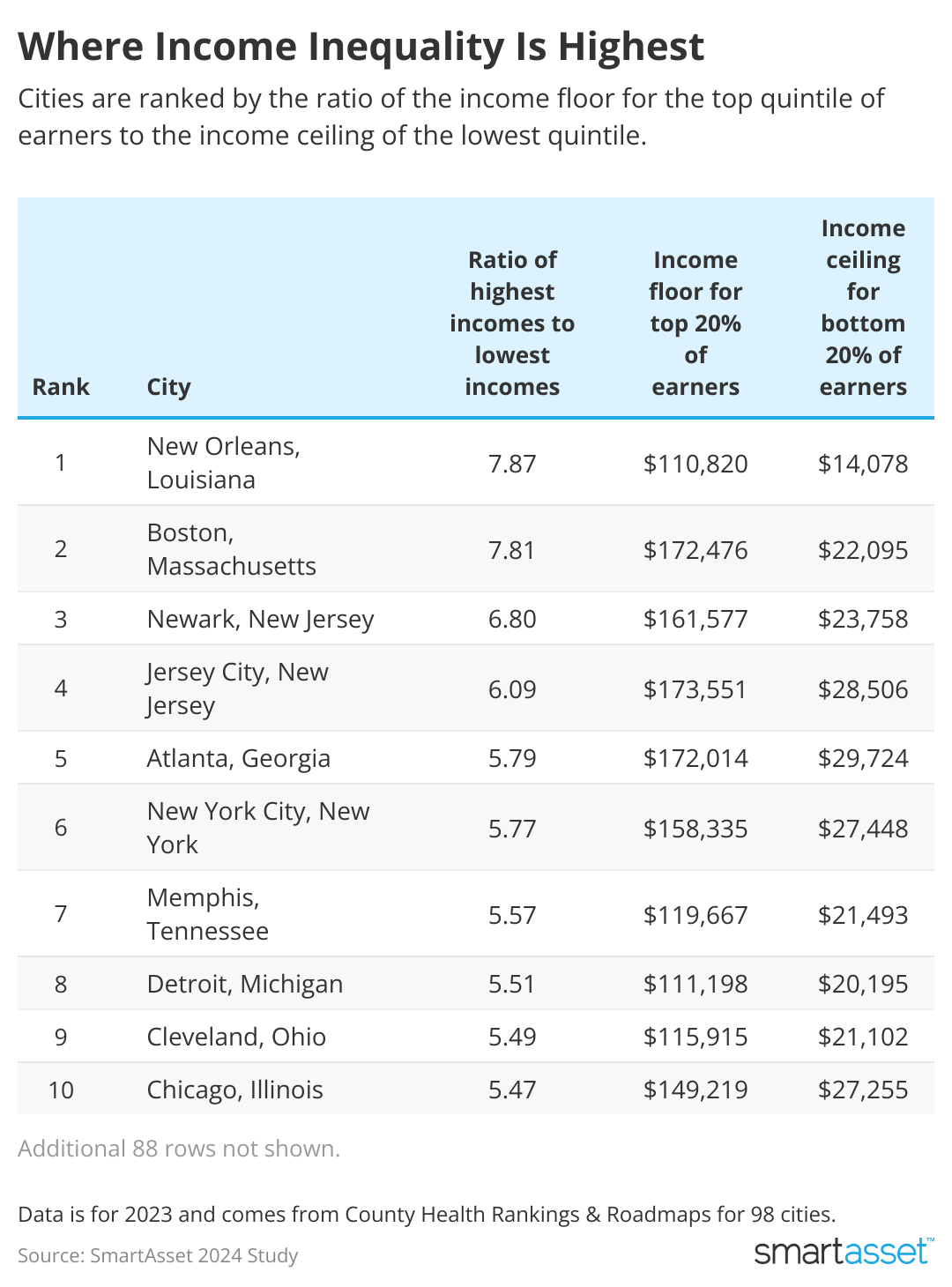
10 cities with the most income inequality
This story was produced by SmartAsset and reviewed and distributed by Stacker Media.
10 cities with the most income inequality
On average, the uppermost 80% of households earn more than four and half times what the bottom 20% earns. For example, in one city, the highest-earning households may average $140k annually or higher – compared to a $30k income earned by the bottom fifth of residents. This income inequality can divide local communities by creating disparities in housing, goods and services.
With this in mind, SmartAsset ranked 98 of the largest U.S. cities by the size of their income inequality, measured by comparing the incomes of the top 80% of earners with the bottom 20%.
Key findings
- New Orleans has the highest income inequality of major U.S. cities. While the highest earners make 7.8 times as much as the lowest earners in New Orleans, they still earn lower than average ($110,800) when compared to other cities. But the bottom 20% of earners in New Orleans has the lowest income ceiling studywide, making less than $14,078 annually.
- Three cities from the New York City metro area rank in the top 10 for highest income inequality. Newark ranks third, with the highest earners making over 6.8 times as much as the lowest earners. Jersey City ranks fourth, at 6.1 times the earnings for the upper quintile. And New York City ranks sixth, with top earners making about 5.8 times more than their low-income counterparts.
- Incomes are most equal in Chesapeake, VA. Thanks to a relatively high-income threshold for the lowest-earning quintile in Chesapeake, high earners only make 3.8 times as much – the smallest multiplier studywide. High earners bring in a minimum of $152,000. Other cities with relatively small income discrepancies are Boise, ID (at 3.9 times) and Aurora, CO (at 4.0 times).
- More than one-fifth of households make more than $200k annually in these cities. The top 80% in Arlington, VA made $233,500 or more. For Bay Area cities, including Oakland and Fremont, CA, the highest earners made more than $223,500. In Seattle, WA, top earners made more than $209,000 annually.

Top 10 cities with the highest income inequality
To determine cities where income inequality is highest, cities are ranked by the ratio of the income floor for the top quintile of earners to the income ceiling of the lowest quintile.
- New Orleans, Louisiana
New Orleans tops the list with an income inequality ratio of 7.87. Income at the 80th percentile is $110,820, while those in the 20th percentile earn $14,078. - Boston, Massachusetts
Boston follows closely with a ratio of 7.81. Income at the 80th percentile is $172,476 and $22,095 for the 20th percentile. - Newark, New Jersey
In Newark, the income inequality ratio stands at 6.80. Those at the 80th percentile earn $161,577 and those at the 20th percentile make $23,758. - Jersey City, New Jersey
The 80th percentile in Jersey City makes at least 6.09 times more than those at the 20th percentile. Income inequality ranges from $173,551 on the high end to $28,506 on the low end. - Atlanta, Georgia
Atlanta's income inequality ratio is 5.79. Those at the 80th percentile earn at least $172,014, while those at the 20th percentile make $29,724. - New York City, New York
New York City's top quintile makes at least 5.77 times as much as the 20th percentile. The highest income is at least $158,335, while those at the 20th percentile earn $27,448. - Memphis, Tennessee
Memphis has an income inequality ratio of 5.57. The 80th percentile income threshold sits at $119,667, while the 20th percentile stands at $21,493. - Detroit, Michigan
The 20th percentile in Detroit makes $20,195. This is 5.51 times less than the 80th percentile, which earns $111,198. - Cleveland, Ohio
In Cleveland, the income inequality ratio is 5.49. The 80th percentile earns $115,915 and the 20th percentile makes $21,102. - Chicago, Illinois
Chicago rounds out the list with high earners making 5.47 times as much as low earners. The highest quintile brings in at least $149,219, while the upper limit of the 20th percentile earns $27,255.
Top 10 cities with the lowest income inequality
- Chesapeake, Virginia
Chesapeake has the lowest income inequality with a 3.78 ratio. The 80th percentile makes $152,165, while the 20th percentile earns $40,204. - Boise, Idaho
Boise's highest earners make at least 3.93 times that of the lowest earners. The 80th percentile makes $138,899 or more, while the 20th percentile brings in $35,305 or less. - Aurora, Colorado
Aurora has an income inequality of 3.97. Those at the 80th percentile make $160,693, while those in the 20th percentile earn $40,448. - Plano, Texas
The income inequality ratio in Plano is 3.98. The 80th percentile income stands at a $190,938 threshold, while the threshold for 20th percentile income sits at $47,947. - Arlington, Virginia
Arlington's high earners make 3.99 times as much as the lowest earners. The 80th percentile earns $233,536 and the 20th percentile makes $58,602. - Anchorage, Alaska
In Anchorage, the income inequality ratio is 3.99. The highest earners make at least $164,038, while the cap for the lowest earners is $41,085. - Colorado Springs, Colorado
The 80th percentile makes $142,226 or more in Colorado Springs. That's at least 4.06 times as much as the 20th percentile, which is $34,997. - Fort Wayne, Indiana
Fort Wayne has an income inequality ratio of 4.10. While the 80th percentile earns $114,163, the 20th percentile makes $27,833. - Madison, Wisconsin
Madison's income inequality ratio is 4.11. Top earners make at least $148,041, while the lowest-earning quintile makes a maximum of $36,001. - Port St. Lucie, Florida
Finally, Port. St. Lucie has an income inequality ratio of 4.12. Residents in the 80th percentile earn $111,882, while those in the 20th percentile make no more than $27,162.
Data and methodology
Cities were ranked by the ratio of household income at the 80th percentile to those of the 20th percentile. Data is for 2023 and comes from County Health Rankings & Roadmaps. Based on Census Bureau population data for 2022, 98 of the largest U.S. cities for which data was available were included. Cities were mapped to county-level data.



